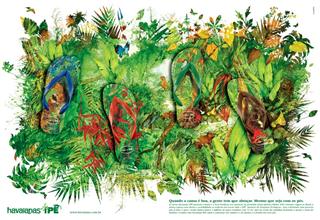Onde Estamos
Rod. Dom Pedro I, km 47
Nazaré Paulista, SP, Brasil
Caixa Postal 47 – 12960-000
Tel: (11) 3590-0041

Since 2004, IPÊ and Havaianas have had a partnership that delights Brazilians and the world through Havaianas IPÊ, sandals with prints that depict the fauna and flora of Brazilian forests. Sold in around 100 countries, they contribute to the conservation of Brazil’s biodiversity, with 7% of net sales going to the Institute.
The mechanics adopted to establish this partnership was Cause Related Marketing (CRM). This is a commercial agreement between a company and a civil society organization and/or cause that uses the power of its brands for mutual benefit. For companies, it is a form of corporate social investment that aligns marketing strategies with the needs of society, using the expertise of their marketing area to promote and mobilize society in favour of a cause. Social institutions can use it as a tool to raise funds and awareness in society.
At Havaianas IPÊ, the use of figures of animals from the Brazilian fauna in the sandal prints was the way found for both Havaianas and IPÊ to add value to their respective brands and generate benefits for biodiversity.
The idea of associating the image of Havaianas with a project that represented social and environmental responsibility already existed within the company, although at the time there was no definition of the format of the partnership or project. IPÊ, for its part, a Civil Society Organization (CSO) until then only known in scientific and academic circles, was looking for national visibility in order to leverage ways of ensuring its long-term sustainability. Thus, with Havaianas sandals (an extremely democratic product), it could spread the name of the organization and the cause of Brazilian biodiversity, giving Brazilians the opportunity to get to know Brazil’s rich nature and support its protection.
The partnership would also contribute to another of IPÊ’s institutional dreams: the formation of an endowment fund, a trust fund that aims to contribute to the organization’s financial sustainability. The royalties agreed at 7% of the net sale of the product are now directed to this conservation fund, which creates the conditions for the organization to continue its work, making it possible to invest in new fronts and increasing administrative professionalism.
The first collection featured the manatee, the black-faced lion tamarin and the red-faced parrot, all endangered animals that were the Institute’s research subjects at the time. For the first time, the Havaianas brand has placed the logo of a civil society organization next to its own on the sole of the product. Over the years, the drawings began to depict other Brazilian animals and their habitats, always with scientific names and information about the species.

The product development process and the communication campaign are planned jointly between the company and the Institute.
The interaction begins with defining the species and details of nature that will be illustrated in each collection. IPÊ is responsible for the technical and scientific content about the animals and their habitats; Havaianas is responsible for creating the artwork and promoting the collection.
No text or piece of advertising is published without the consent of the parties involved and there has always been great concern about the transparency of the information that should reach the public, such as the percentage reverted to IPÊ and what has been achieved with the resources generated by the partnership.
The Havaianas IPÊ partnership is still going strong, with a joint and continuous effort to develop collections that are always attractive and commercially competitive, with messages that aim to reach the end consumer in a way that makes them aware of and involved in the cause of environmental conservation.
The sales have effectively contributed to the organization and the continuation of its projects, as well as publicizing endangered species of Brazilian fauna, many of which are unknown to a large part of the population. As of 2018, the collection has sold more than 14.3 million pairs, which has donated more than 8.2 million reais to IPÊ. For Alpargatas S.A and Havaianas, this is a creative way of assuming social and environmental responsibility, setting an example of corporate commitment and modernity. Consumers, on the other hand, have the opportunity to buy a product that portrays Brazil’s natural beauty, as well as knowing that they are contributing to its conservation.
Campaigns
In 2010, a campaign reaffirmed the success of the partnership: the virtual auction of a mini-forest made from certified wood, depicting the Atlantic Forest and Amazon species that have already been and are now part of the Havaianas IPÊ sandal collections. The highest bidder took the forest, which was displayed on a hotsite and the proceeds were donated to IPÊ’s projects. VIDEO

In 2014, it was time to tell the story of the tapir’s life to consumers of the sandals. The proposal was to provide information about the importance of the species for Brazilian biodiversity – the tapir as a gardener of the forests – and to show that, by buying Havaianas-IPÊ, consumers are supporting IPÊ projects such as this one, which works to protect the tapir in the Atlantic Forest, Pantanal and Cerrado. VIDEO.
About Havaianas
A worldwide success, Havaianas is a genuinely Brazilian brand. The product began to be produced in 1962 by Alpargatas, inspired by Japanese rice straw sandals (Zori), made with strips of fabric. In place of straw came rubber, which is tough, soft and built to last. The grain of rice inspired the texture of the insole. The name was borrowed from Hawaii, designed by Hollywood as a dream location in the 60s. Produced with white soles and blue straps, the novelty fell in love with consumers and two years after its launch, it was already on the feet of most Brazilian workers.
Over the years, the fame of the product’s quality spread even further, the sandals were given new colors in addition to the blue straps and, in 1995, the first printed Havaianas were brought to the market. From then on, the brand evolved, following the spirit of its time and launching trends. Models and celebrities from Brazil and abroad have also started wearing the sandal on their feet. Exports progressed and the brand found a place in magazines and in the world’s main fashion showcases.
In the following years, the brand continued to diversify and innovate even more, with launches such as Havaianas Slim, the Soul Collection line, Havaianas Flat, its own clothing collection, galoshes, and the eyewear line, launched in 2016.
Check out more about the history of Havaianas.
About Alpargatas
The leading Brazilian footwear company in Latin America, Alpargatas owns popular brands such as Havaianas, Dupé, Osklen, Topper in Argentina, Sete Léguas and Meggashop and holds the license for Mizuno in Brazil. The company offers innovative products with differentiated technology and design and has expertise in building and managing global brands, which provide a relationship of admiration and trust with consumers. With net profits of R$358.5 million in 2016 (up 36% on the previous year), Alpargatas has factories in Brazil and Argentina, 698 stores around the world and its products are present in more than 100 countries.
Rod. Dom Pedro I, km 47
Nazaré Paulista, SP, Brasil
Caixa Postal 47 – 12960-000
Tel: (11) 3590-0041
Termos de Uso | Estatuto
Copyright © Ipê – Instituto de Pesquisas Ecológicas.
Email: ipe@ipe.org.br